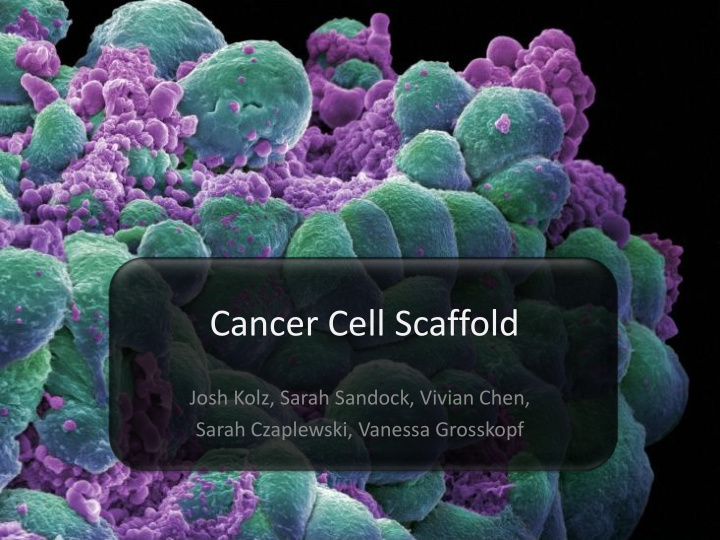



Cancer Cell Scaffold Josh Kolz, Sarah Sandock, Vivian Chen, Sarah Czaplewski, Vanessa Grosskopf
Outline • Background – Bioreactor – Cell Scaffold – MRI – Cancer cells • Motivation • Design – Criteria – Alternatives • Matrix • Final design • Future work
Bioreactor & Scaffold • System to grow and sustain cells • Bioreactor encases cell scaffold • Scaffold provides site for cells to attach
13 C MRI Hyperpolarization • Hyperpolarization: nuclear spin polarization of a material ( 13 C, 1 H) far beyond thermal equilibrium • MRI tracks decay of hyperpolarized proton • Used to assess cancer malignancy and treatment – Glycolysis up-regulated in cancer cells – 13 C-labeled pyruvate used to monitor glycolytic pathway
Experimental Cell Lines • Cell Lines • Lymphoma K562 • Leukemia NKL • Prostate Cancer: PC3, DU145, LNCap • Brain Glioma: U251, U87 • Breast Cancer: T47D • Characteristics • Self-proliferating • Overproduction of ECM • Increased ease of culturing
Project Motivation • Controlled cell culture experiments provide superior method of monitoring cancer cell metabolism • Bioreactor and cell scaffold required • Scaffold must promote cell growth to a high density to track metabolism
Design Criteria • Large surface area : volume ratio • High cell density (50*10 6 cells/ml ) • Maintain cell viability (~4 days) • Allow perfusion of fluids • Ensure proper inoculation • Non-ferrous material
Encapsulation • Calcium alginate bead with cells inside • Primarily used with tumorous liver cells • Grow to a desirable density • Time consuming to construct • Size, shape, and cell density can vary
Microcarriers • Dextran (polysaccharide), glass, polystyrene (polymer) • 125-300 μ m • Often used in bioreactors • Coated or uncoated (collagen, FACT, ProNectin F) • Different porosities and surface chemistries
Microcarriers • Cytodex 3 – Cross-linked dextran beads with collagen layer, microporous • Biosilon Nunclon Delta Microcarriers – Polystyrene with surface treatment to promote adhesion, nonporous • Sigma-Solohill Microcarrier Beads – Polystyrene beads coated with collagen, nonporous
ECM Scaffolds • Cancer research commonly utilizes – Alginated scaffolds (bought/made) – Fibrin scaffolds (bought/made) – Collagen • Lab-made options – Cheap – High surface area • Tumor cell specific research • Not present in bioreactor research
Hollow Fibers • Tailored for use in a bioreactor • Cartridge of many tubule membranes • Large surface area • Can be coated with ECM proteins • Precedence with cancer cell lines • Membranes cause noise in MRI
Design Matrix Type of Matrix Surface Cell Presence in Cost Change in Viability Ease of Total Area Specificity Bioreactors 10 Phenotype? Fabrication 100 (Density) 20 15 5 15 10 25 Encapsulation Calcium 21 14 12 9 5 15 1 77 Alginate Microbeads Cytodex 3 22 17 15 9 5 15 10 93 Biosilon 19 15 8 5 15 10 95 23 Nunclon microcarriers Collagen 19 15 9 5 15 10 96 23 Coat e d Polystyrene microcarriers Hollow Fibers 24 18 15 6 5 15 8 91 3-D Gel Algenated 15 14 0 1/8 5 15 8/1 58 Structures Bought/made Fibrin 14 0 1/8 5 15 8/1 58 15 Bought/made Collagen 14 0 2 5 15 8 59 15
Final Design Sigma-Solohill • Polystyrene microcarrier • Coated in collagen • T47D breast cancer cells • Large surface area (3.6*10 6 cm 2 /bead) • $5 / experiment ($160.70/20g)
Future Work Determine Integration & Order Seeding Density Total Amount Testing within Densities Quantification Product Needed Bioreactor
References Text Cell Max Hollow Fiber Bioreactor (2010). Spectrum Labs . Retrieved February 26, 2011, from http://www.spectrumlabs.com/cell/MaxCarts.html Chandrasekaran, P., Seagle, C., Rice, L., MacDonald, J., & Gerber, D. A. (2006). Functional analysis of encapsulated hepatic progenitor cells. Tissue Engineering, 12 (7), 2001-2008. Harris, T., Eliyahu, G., Frydman, L., & Degani, H. Kinetics of hyperpolarized 13C1-pyruvate transport and metabolism in living human breast cancer cells. PNAS , 106 (43), 18131-18136 Keshari, K., Kurhanewicz, J., Jeffries, R., Wilson, D., & Dewar, B. Hyperpolarized 13C spectroscopy and an NMR-compatible bioreactor system for the investigation of real-time cellular metabolism. Magnetic Resonance in Medicine , 63 , 322-324 Rowland, I., Peterson, E., Gordon, J., & Fain, S. (2010). Hyperpolarized13C MR. Current Pharmaceutical Biotechnology , 11 , 709-719. Images http://www.bioe.umd.edu/news/news_story.php?id=5312 http://www.bioprocessintl.com/multimedia/archive/00103/BPI_A_100807AR30_O__103800b.jpg http://www.equl.com/products/image/e0156.jpg http://www.gelifesciences.com/APTRIX/upp01077.nsf/Content/Products?OpenDocument&parentid=6669 21&moduleid=167176#content
Questions?
Recommend
More recommend